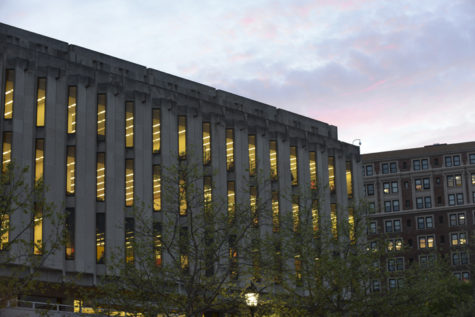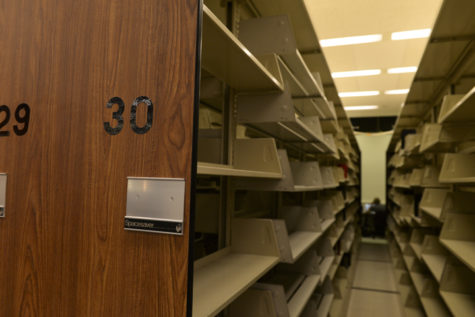When Hillman Library opened in 1968, crates of books waited to be unloaded onto the new shelves — and asbestos lined the building’s infrastructure.
Now, renovation will mean some of those same books from 1968 will disappear from the library’s shelves — a process that will also remove the asbestos that has been in the building since its construction.
The renovations, which Pitt Director of Environmental Health and Safety Jay Frerotte isn’t because of the asbestos specifically, will also increase study space, add amenities such as outlets and improve the facility’s wireless connection. The renovations are slated to begin in May, and may take up to five years to complete.
According to Pitt English professor Steven Carr, who sat on the Facilities Planning Committee in 2006, state regulations forced the committee to incorporate a way to address any present asbestos as it formed the 10-year facilities plan and before beginning renovations on the library.
Intact asbestos materials can be disturbed when fibers fly into the air during construction, which can cause airborne exposure to asbestos, increasing an individual’s risk for lung cancer and mesothelioma. Carr said the library is obligated to carry out the proposed renovation floor by floor in order to treat the asbestos properly.
“It’s not dangerous right now because it’s not being disturbed, but if it’s disturbed you have to get rid of it,” Carr said.
Asbestos minerals were once widely used for construction purposes, especially during the late 1900s. Manufacturers used the minerals in fire retardant coatings, concrete, bricks, pipe cement, insulation, flooring and roofing, until a group of English researchers and factory investigators discovered in the early 20th century the health risks of exposure to the substance.
Because asbestos is only harmful if it is airborne, a large number of buildings constructed using asbestos-containing materials have not been renovated.
Certified professionals will carry out the asbestos removal at Hillman and will work behind protective plastic barriers to ensure that dust does not become airborne. The ACHD will then need to provide a clearance inspection to ensure that all asbestos-containing material has been removed, before the library can proceed with the next steps of the renovation.

Frerotte said these cautious procedures will mean the asbestos removal process will not be of any health threat to people in the library.
The Pitt News approached several librarians for interviews about the renovations in general, but they refused to comment without permission from Web Services and Communications Librarian Jeffrey Wisniewski. When The Pitt News approached Wisniewski, he said that any interviews would not be helpful to the renovation.
The U.S. Environmental Protection Agency demands workers follow specific guidelines when dealing with disrupted asbestos, which Pitt will have to follow when building renovations begin. The Allegheny County Health Department Air Quality Program requires a thorough evaluation to measure the presence of asbestos in a facility that is being demolished or renovated.
The renovations began in the first place in part because of student complaints of limited study space and a lack of variation between group work and quiet study areas. In order to provide increased study space, the renovation plan will remove a large portion of physical books from the library, moving them instead into long-term storage.
Although students will still be able to find these books through the library’s online databases, they won’t be able to stumble across texts unexpectedly anymore — something graduate student and teaching fellow Jess FitzPatrick found useful. When she was looking for “The Well Wrought Urn” one day, she came across a handful of other texts that she ended up referencing for classes.
“Next to it of course there were four or five other books that I didn’t know to look up, didn’t know the title of, I hadn’t heard about before, that might be really useful,” she said.
FitzPatrick and other University professors such as Carr, find that digitalization or searching for particular books using PittCat and having them shipped to the library in a physical copy just isn’t the same or as exciting as roaming the shelves.

The renovation planners at Hillman assembled an interactive floor map, which can be found on the library’s website, to help navigate the dense stacks of books. The website also houses a materials-movement timeline that provides the Pitt community with a calendar of which books are moving and when. And there are daily deliveries to the storage facility, so that the library can guarantee a 24- to 48-hour turnaround time whenever a student or faculty member requests a book on PittCat.
To make room for more study space, the renovations will begin on the fourth floor. The fourth-floor books that students and faculty rarely check out will head to the ULS storage facility on Thomas Boulevard in Point Breeze. Other portions of the library’s collection will move to the ground floor compact shelving, the Engineering Library in Benedum Hall or will move to the second floor of Hillman, replacing about half of the East Asian Library, which will move to the Point Breeze storage facility. Ground floor government documents and journals printed before 1970 will end up in storage as well.
The library staff has a detailed removal plan and method for transferring books out, but don’t be surprised if you see some of those old crates from the ’60s out again to fit the large outflow of the library’s collections.
After the renovations and book removal, scholars will be more dependent on the ULS’ online resources to track down the texts they need for research projects or classes.
Senior psychology major Jen Doto has used the ULS online databases as well as the Digital Scholarship Commons during most of her undergraduate career. The renovation project to replace books with practical study space seems like the logical step forward to Doto.
“This semester, which is my last one, was the first time that I ever checked out a book here,” Doto said. “To be quite honest, I guess the internet is taking over mostly.”



